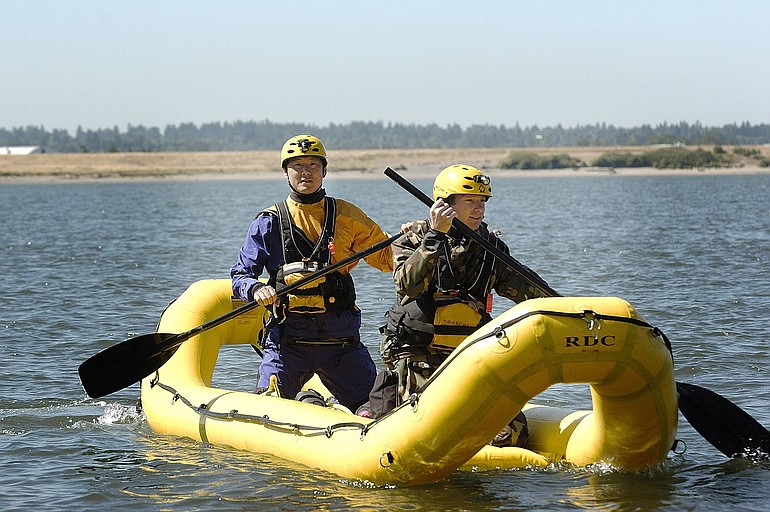As they traveled to the banks of the Lewis River under the cover of night, Vancouver Fire Capt. Geoff Robbins knew a family of three was stranded with a deflated raft, and he knew that he’d be rafting with his team downriver to get them in overflowing, fast-moving waters.
“It was a high-risk situation,” said Robbins, who leads the Vancouver Fire Department unit that makes up part of the Regional Tactical Rescue Team.
Robbins, along with Todd Knoeppel, a firefighter and paramedic, and firefighter Jae Munson set in about a mile upriver from the family and navigated the Lewis River after midnight to the spot where they were stuck.
Robbins’ crew reached Heith Hammond, 31, and his two daughters, ages 9 and 10, and paddled them about a quarter-mile to safety. The June 6 expedition to retrieve the Hammond family is one example of the rescues for which Robbins’ team is responsible, the captain explained Wednesday at Wintler Park as he showed off the unit’s gear.
“To go raft a flood-stage river in the middle of the night, that was a call,” Robbins said.
The Vancouver Fire Department and its heavy rescue unit — a $1.5 million tool-filled truck capable of responding to nearly any event imaginable — joins with Clark County Fire District 6 to make up the Regional Tactical Rescue Team, which is responsible for Clark, Cowlitz, Skagit and Wahkiakum counties.
The tactical response unit’s equipment is funded by the Department of Homeland Security and various grants.
Knoeppel and Munson are two of three members who rotate onto Robbins’ squad. They dug into the toolbox Wednesday to show off the rapid deployment craft, which looks like a banana in shape and color. They used an air tank to inflate the raft in about 90 seconds and easily maneuvered the craft near the edge of the Columbia River, turning smoothly in the barely moving water.
Robbins said he’s been called to water rescues “six or seven” times in the past two months, a span that began around the Lewis River retrieval through the recent rescue of a boy whose foot got wedged between boulders as he swam near Dougan Falls last week.
Kea Rodrigues, the 14-year-old pulled from the Upper Washougal River, remains in critical condition, a hospital official said Thursday night.
Robbins said he arrived near the end of the rescue effort and his team set up a low-angle rope to tow the boy to shore. He declined to offer additional comment on the response.
The tactical response team is made up primarily of firefighters who enter the department with significant water experience. Robbins was a lifeguard in the San Diego area. Knoeppel was a pararescueman with the Air Force, and Munson learned to respect the water as a surfer.
“The comfort of being in the water is something you can’t train,” Robbins said.
The tactical rescue unit is meant to augment other agencies in situations that require a “specialized resource,” said Jim Flaherty, a fire department spokesman.
“It’s really an orchestrated dance to make it all happen,” Flaherty added.
As the summer heats up, the unit’s workload is likely to rise, too. Water tends to lag behind air temperatures, sending swimmers into shock when their bodies meet cooler temperatures beneath the surface.
“We’re starting to get more calls,” Robbins said. “It seems we get one a week out of our area.”
The unit trains in fast-moving waters once a year, including an excursion this past spring on the Washougal River.
Some of the more challenging rescues require the use of what Robbins called a “tether.” The technique is put to practice in quick waters when an individual is stranded on an object, most commonly a rock.
A pulley system is set up to pull the trapped victim to safety. It’s situations like those — along with outings such as the Lewis River rescue — that test the team’s mettle.
“For going in swift water, we go where motorized boats can’t,” Robbins said, pointing to banana boat paddled by Knoeppel and Munson. “That’s the ticket.”



